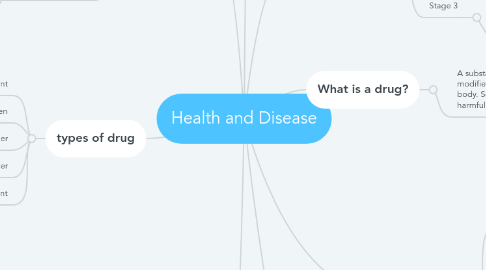
1. types of drug
1.1. Depressant
1.1.1. Slows down nerve and brain acivity
1.1.1.1. Alcohol, Solvents, Temazepam
1.2. Hallucinogen
1.2.1. Alters what we see and hear
1.2.1.1. LSD
1.3. Painkiller
1.3.1. Blocks nerve impulses
1.3.1.1. Aspirin, Paracetamol
1.4. Performance enhancer
1.4.1. Improves muscle development
1.4.1.1. Anabolic steroids
1.5. Stimulant
1.5.1. Increases nerve and brain activity
1.5.1.1. Nicotine, Caffeine, Ecstasy
2. Classification of drugs
2.1. Illegal drugs
2.1.1. Classified A, the most dangerous with the most serious penalties for possession to C, the least dangerous with the lightest penalties, this does not mean they are safe to use
3. Antibiotics
3.1. Penicillin
3.1.1. The first antibiotic discovered in 1928 by Alexander Fleming. He noticed that some bacteria he'd left in a Petri dish had been killed by naturally occurring penicillium mould
3.2. slow down or stop growth of bacteria, they do not kill viruses
3.3. Different antibiotics
3.3.1. Different bacteria cause different diseases. One antibiotic may only work against one type of bacteria or a few. This means a range of antibiotics are needed for the treatment of the whole range of bacterial diseases
4. What is a drug?
4.1. A substance taken into the body that modifies or affects chemical reactions in the body. Some are beneficial, while others are harmful
5. Drug testing
5.1. Stage 1
5.1.1. Drugs tested using computer models and human cells grown in the lab
5.2. Stage 2
5.2.1. Drugs that passed first stage are tested on anias, a known amount of substance is given to the animal and is monitored carefully for any side-effects
5.3. Stage 3
5.3.1. Drugs that have passed stage 1 and 2 are tested on healthy volunteers to check they're safe. If they are people with the illness are tested to ensure that the drug works and that it is safe
6. Clinical Trials
6.1. A group of volunteers called the test group receives the new drug
6.2. Another group called the control group receive the existing drug for that illness, if there is no existing drug they are given a placebo
6.3. Two main types
6.3.1. Blind trials- volunteers do not know which group they are in but researchers do
6.3.1.1. easily set-up but less reliable due to accidental bias
6.3.2. Double-blind trials- Neither volunteers nor researchers know which group the volunteers are in until the end of the trial
6.3.2.1. more reliable as researchers don't accidentally show they know who has the drug in test
7. Smoking
7.1. Legal
7.2. Tobacco
7.2.1. Nicotine
7.2.1.1. Addictive substance
7.2.2. Tar
7.2.2.1. Carcinogen
7.3. Carbon Monoxide
7.3.1. Combines with haemoglobin in red blood cells and so reduces the ability of the blood to carry oxygen. This puts extra strain on the circulatory system, and can cause an increased risk of heart disease and strokes
7.4. Increases risk of lung cancer, Throat cancer and Mouth cancer
8. Alcohol
8.1. Legal
8.2. Ethanol
8.2.1. Depressant
8.2.1.1. Slows down signals in the nerve and the brain
8.3. Liver removes alcohol from bloodstream. It has enzymes that break down alcohol but the products of the reaction involved are toxic
8.4. Effects
8.4.1. Short-term - Sleepiness and impaired judgement, balance and muscle control which leads to blurred vision and slurred speech
8.4.2. Long-term - Damage to the liver and brain, over time this leads to cirrhosis, scarring of the liver.

